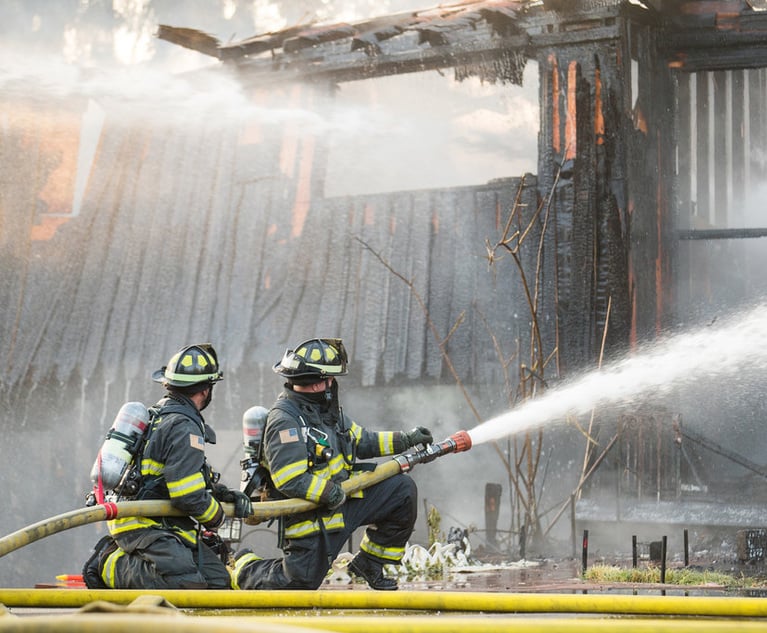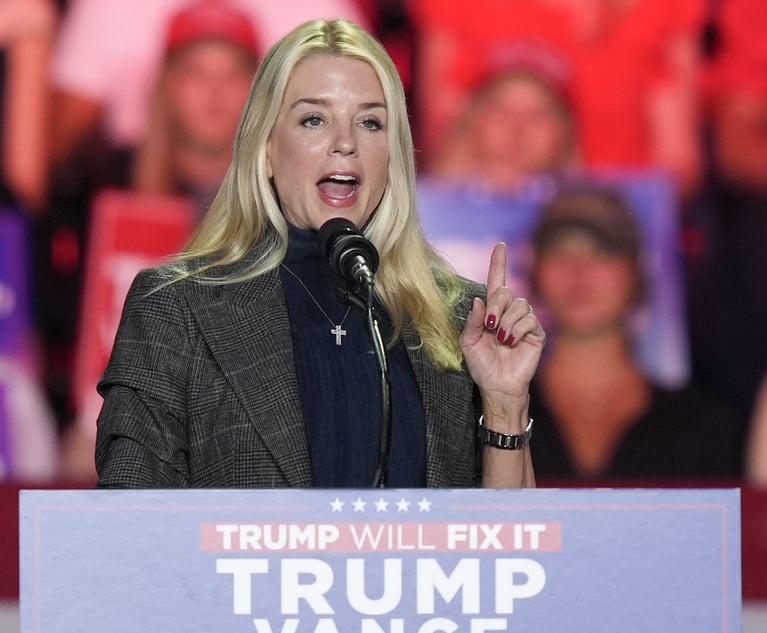Grand Reopening: Guidelines for Resuming Business Operations in Calif. Amid COVID-19
As the spread of COVID-19 slows and the pressure to reopen intensifies, states are easing the restrictions of stay-at-home orders and adopting plans to reopen their economies. Every California business and property owner encounters at least two important questions—When can we open our business or property, and what are the rules?
June 03, 2020 at 04:55 PM
8 minute read
 Gregg J. Loubier and Sue Chang of Alston & Bird
Gregg J. Loubier and Sue Chang of Alston & Bird
As the spread of COVID-19 slows and the pressure to reopen intensifies, states are easing the restrictions of stay-at-home orders and adopting plans to reopen their economies. Every California business and property owner encounters at least two important questions—When can we open our business or property, and what are the rules? This article examines California state and local mandates and industry-specific guidelines for determining when and how commercial businesses can reopen in California.
California's Four-Phase Reopening Plan
Given California's size and diversity, the state's reopening plan is a model for how reopening is being managed. California has adopted a four-phase reopening plan based on each county's degree of readiness. No business may reopen until authorized by the state's order. California's "Resilience Roadmap" outlines phased guidelines for incremental reopening. The Resilience Roadmap consists of four stages. Stage 1 permits only essential businesses to open. Early Stage 2 permits retail businesses with curbside pickup, logistics and manufacturing, office workplaces, limited personal services, outdoor museums, childcare and essential businesses to open with health and safety modifications. Expanded Stage 2 covers destination retail, dine-in restaurants and schools, with modifications. Stage 3 permits higher-risk workplaces to reopen at a pace designed to protect public health and safety, beginning with limited personal care and recreational venues, with workplace modifications. Stage 4 will gradually open larger-gathering venues at a pace consistent with public health and safety such as nightclubs, concert venues and live audience sports.
The ability of California businesses to reopen and the pace of reopening depends on successful area-wide containment of the virus. A county that can demonstrate progress containing COVID-19 can move through a stage faster as it meets the readiness criteria defined by the California Department of Public Health (CDPH). Those counties must file an attestation form available on the CDPH website. Once approved, the county will be permitted to open more businesses as outlined in the county variance guidance. A list of attested counties can be found on the CDPH's website.
Currently, California is in Stage 2 statewide. This means that, unless the county where the commercial building or business is located has attested for accelerated opening, the county is in Stage 2. As of May 18, 50 of 58 counties were approved to move into Expanded Stage 2. On May 26, Gov. Gavin Newsom announced that the state will transition into Stage 3, which includes reopening of hair salons and barber shops with workplace modification. However, Newsom has not set a specific date for California to enter into Stage 3 statewide. As of May 30, all counties but Alameda, Contra Costa, Imperial, Marin, San Francisco, San Mateo and Santa Clara counties were allowed to move into Expanded Stage 2 or Stage 3.
Guidelines for Reopening
Businesses may successfully reopen and limit potential liability by complying with governmental orders and by implementing industry best practices to protect the health and safety of tenants, employees, customers and clients. There are numerous resources supporting the preparation of an effective safe reopening plan for a property or business. The mechanics of reopening vary for each business; there is no one-size-fits-all. Useful resources include:
- California Resilience Roadmap
- California industry-specific guidance
- Hotels and Lodging – Guidance and Checklist
- Office Workspaces – Guidance and Checklist
- Retail – Guidance and Checklist
- Shopping Centers – Guidance and Checklist
- California Department of Public Health (CDPH)
- Centers for Disease Control and Prevention (CDC)
- Occupational Health and Safety Administration (OSHA)
- Building Owners and Managers Association (BOMA)
- National Association of Industrial and Office Properties (NAIOP)
- California Hotel and Lodging Association
- California Restaurant Association
The available materials and recommendations for reopening are accessible and useable, though the volume and detail can be daunting. Most of the guidelines from both government and industry include common elements that should be included in a well-prepared safe reopening plan:
- COVID-19 task force. Establish a task force to direct reopening. Understand federal, state and local mandates and recommendations as well as guidelines from regulatory and public health agencies. Develop a safe reopening plan consistent with state, local and other regulatory guidance and requirements, and designate a person at the location to implement the plan. Communicate rules, procedures and protocols to affected persons.
- Employee health strategies and training. Train employees on infection prevention measures, self-screening at home, COVID-19 symptoms and the importance of frequent handwashing, physical distancing and proper use of face coverings and personal protective equipment.
- Entry to worksite strategies. Develop policies and procedures for prompt identification and isolation of COVID-19-symptomatic persons. Employers should provide and ensure workers use all required protective equipment. Provide temperature or symptom screenings for all workers at the beginning of their shifts and for any personnel entering the facility. Encourage workers who are sick or exhibiting symptoms of COVID-19 to stay home.
- Cleaning and disinfecting protocols. Develop a sanitation plan. Perform thorough cleaning using products on the EPA-approved list. Provide hand sanitizers and hand-washing stations.
- Physical distancing guidelines. Reconfigure spaces and utilize signage, floor markings and other visual guides to communicate and manage social distancing. Establish rules for the safe use of elevators, common areas and amenity spaces; restricted use of shared equipment, supplies and space; and safe security and building access.
Local Reopening Rules
Local rules may establish mandatory elements of a safe reopening plan for businesses and properties. For example, San Diego County issued a health order requiring all essential businesses and other reopened businesses to conduct temperature screening of all employees and prohibit employees with a temperature of 100 degrees or more from entering the workplace. Symptom screening may be used only when a thermometer is not available. San Diego County also requires all reopened businesses to prepare and post a "safe reopening plan" for each facility. The plan must be posted at or near the entrance of the facility and be easily viewable by the public and employees. A copy of the plan must also be provided to each employee performing work at the facility. Violation of this order is subject to fine, imprisonment or both. Essential businesses that have remained open and allow members of the public to enter a facility must also post a "Social Distancing and Sanitation Protocol." A properly prepared and implemented safe reopening plan will follow local rules.
Entertainment Industry Response
COVID-19 has severely impacted motion picture and television production worldwide. On June 1, 2020, a coalition of motion picture and television producers, unions, artists and directors issued a white paper with proposed guidelines for resuming production. The guidelines issued by the Industry-Wide Labor Management Safety Committee Task Force establish recommendations to support governmental approval to reopen in affected jurisdictions. The guidelines focus on implementation and management of the reopening plans and guidelines, infection control including physical distancing and protective equipment, cleaning and sanitation protocols, health screening, and training and education. The guidelines seek to address the enormity of the task the industry confronts. Many types of talent and workers must be protected in disparate locations operating through numerous industry groups and unions under varying laws and regulations, with those groups and locations having independent yet connected responsibilities to manage the guidelines and the law.
Legal Liability
Businesses and property owners are subject to potential legal liabilities related to COVID-19. Several states have passed laws giving targeted businesses varying levels of immunity from certain COVID-19 claims. California is not among those states. Industry groups continue to lobby Congress for liability protections, which some in Congress have pledged to include in future COVID-19 legislation. In the absence of protection under the law, contract parties are examining ways to allocate and shift the risks of COVID-19 liability. For example, landlords may consider amending leases to add new insurance requirements and hold-harmless protection. In the meantime, the reopening of a business or property presents an opportunity to establish and follow a well-prepared safe reopening plan based on best practices described by government and industry as a practical means to create a safe environment and limit potential liability.
Reopening guidelines continue to evolve. Phased reopening in urban areas may be affected by recent unrest and curfews. Businesses should monitor developments and rely on legal counsel to effectively respond to changes and continue to implement best practices during the inevitable process of reopening and recovery from the pandemic.
Gregg J. Loubier and Sue Chang work in Alston & Bird's finance practice group in Los Angeles, where clients rely on them to guide, negotiate and document transactions, solve problems and resolve disputes in real estate and real estate finance.
This content has been archived. It is available through our partners, LexisNexis® and Bloomberg Law.
To view this content, please continue to their sites.
Not a Lexis Subscriber?
Subscribe Now
Not a Bloomberg Law Subscriber?
Subscribe Now
NOT FOR REPRINT
© 2025 ALM Global, LLC, All Rights Reserved. Request academic re-use from www.copyright.com. All other uses, submit a request to [email protected]. For more information visit Asset & Logo Licensing.
You Might Like
View All

LA-Area Law Firms Offer Support as Region Reckons With Raging Wildfires

Once the LA Fires Are Extinguished, Expect the Litigation to Unfold for Years
5 minute read
'Not the President's Personal Lawyer': Lawyers Share Concerns Over How AG Pick Bondi’s Loyalism to Trump May Impact DOJ
6 minute readLaw Firms Mentioned
Trending Stories
Who Got The Work
J. Brugh Lower of Gibbons has entered an appearance for industrial equipment supplier Devco Corporation in a pending trademark infringement lawsuit. The suit, accusing the defendant of selling knock-off Graco products, was filed Dec. 18 in New Jersey District Court by Rivkin Radler on behalf of Graco Inc. and Graco Minnesota. The case, assigned to U.S. District Judge Zahid N. Quraishi, is 3:24-cv-11294, Graco Inc. et al v. Devco Corporation.
Who Got The Work
Rebecca Maller-Stein and Kent A. Yalowitz of Arnold & Porter Kaye Scholer have entered their appearances for Hanaco Venture Capital and its executives, Lior Prosor and David Frankel, in a pending securities lawsuit. The action, filed on Dec. 24 in New York Southern District Court by Zell, Aron & Co. on behalf of Goldeneye Advisors, accuses the defendants of negligently and fraudulently managing the plaintiff's $1 million investment. The case, assigned to U.S. District Judge Vernon S. Broderick, is 1:24-cv-09918, Goldeneye Advisors, LLC v. Hanaco Venture Capital, Ltd. et al.
Who Got The Work
Attorneys from A&O Shearman has stepped in as defense counsel for Toronto-Dominion Bank and other defendants in a pending securities class action. The suit, filed Dec. 11 in New York Southern District Court by Bleichmar Fonti & Auld, accuses the defendants of concealing the bank's 'pervasive' deficiencies in regards to its compliance with the Bank Secrecy Act and the quality of its anti-money laundering controls. The case, assigned to U.S. District Judge Arun Subramanian, is 1:24-cv-09445, Gonzalez v. The Toronto-Dominion Bank et al.
Who Got The Work
Crown Castle International, a Pennsylvania company providing shared communications infrastructure, has turned to Luke D. Wolf of Gordon Rees Scully Mansukhani to fend off a pending breach-of-contract lawsuit. The court action, filed Nov. 25 in Michigan Eastern District Court by Hooper Hathaway PC on behalf of The Town Residences LLC, accuses Crown Castle of failing to transfer approximately $30,000 in utility payments from T-Mobile in breach of a roof-top lease and assignment agreement. The case, assigned to U.S. District Judge Susan K. Declercq, is 2:24-cv-13131, The Town Residences LLC v. T-Mobile US, Inc. et al.
Who Got The Work
Wilfred P. Coronato and Daniel M. Schwartz of McCarter & English have stepped in as defense counsel to Electrolux Home Products Inc. in a pending product liability lawsuit. The court action, filed Nov. 26 in New York Eastern District Court by Poulos Lopiccolo PC and Nagel Rice LLP on behalf of David Stern, alleges that the defendant's refrigerators’ drawers and shelving repeatedly break and fall apart within months after purchase. The case, assigned to U.S. District Judge Joan M. Azrack, is 2:24-cv-08204, Stern v. Electrolux Home Products, Inc.
Featured Firms
Law Offices of Gary Martin Hays & Associates, P.C.
(470) 294-1674
Law Offices of Mark E. Salomone
(857) 444-6468
Smith & Hassler
(713) 739-1250






